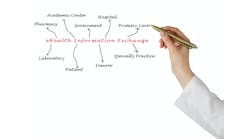Forthcoming regulations from federal policymakers will penalize stakeholders who engage in information blocking that prevents the flow of health data, as outlined in the 21st Century Cures Act. But a new survey of health information exchanges (HIEs) finds that the majority of respondents—55 percent—reported that electronic health record (EHR) vendors still at least sometimes engage in information blocking, while 30 percent of HIEs reported the same for health systems.
The study, conducted between May 2019 and February 2020 by health policy researcher Julia Adler-Milstein, Ph.D., of the UCSF School of Medicine, Jordan Everson, Ph.D., a health policy professor at measure the prevalence of information blocking behaviors observed by these third-party entities.
The information blocking concept was originally defined by Congress in the Cures Act, and the concept entails interfering with, preventing, or materially discouraging access, exchange, or use of electronic health information. Information blocking “is a practice that is profoundly anti-consumer and anti-competition. Information blocking can be used to increase revenue, escalate prices, and prevent market competition both for current and future competitors and for new services,” according to the Act. The Cures Act tasked ONC to define what doesn’t constitute data blocking, and agency’s final regulation released last March clarifies where penalties will be enforced and exceptions granted.
Federal health officials who are looking to clamp down on information blocking practices routinely cite a 2016 study of 60 HIE leaders that was also spearheaded by Adler-Milstein. Per that research, half of leaders of health information exchange efforts nationwide reported they routinely encountered information blocking by health IT developers. The top three types of information blocking practices they encountered on a routine basis included: deployment of products with limited interoperability (49 percent); high fees for health information exchange unrelated to cost (47 percent); and making third-party access to standardized data difficult (42 percent).
Because information blocking in of itself can be quite subjective, ONC also finalized eight exceptions to information blocking. Originally supposed to take effect last fall, federal officials pushed back the compliance date for stakeholders until April 5, 2021 due to the pandemic. By that date, however, certain requirements related to the information blocking and Conditions and Maintenance of Certification (CoC/MoC) requirements will have to be met. If not, “bad” actors will be subject to significant penalties—perhaps up to $1 million per information blocking violation.
The latest research, published in JAMIA, reveals that 55 percent of HIEs reported that EHR vendors at least sometimes engage in information blocking, while 30 percent of HIEs reported the same for health systems. The most common type of information blocking behavior EHR vendors engaged in was setting unreasonably high prices, which 42 percent of HIEs reported routinely observing. The most common type of information blocking behavior health systems engaged in was refusing to share information, which 14 percent of HIEs reported routinely observing.
What’s more, greater developer competition was associated with higher reported levels of information blocking, the research showed. In relatively competitive developer markets, 47 percent of HIEs reported high levels of information blocking by vendors, and 14 percent reported low levels. In contrast, 16 percent of HIEs located in relatively low competition markets reported high levels of information blocking, while 58 percent reported low levels of information blocking.
This trend was less evident for health system competition with the same percent of HIEs (31 percent) indicating high and low information blocking in markets with high health system competition. In less competitive markets, 19 percent of HIEs reported high levels of information blocking, and 38 percent reported low levels of information blocking.
Reacting to these data points, the researchers offered, “While competition between health systems is also correlated with information blocking by health systems, the relationship is not as strong as among vendors. This may be due to nuances in how health systems choose to share information. Prior work on health system behavior has indicated that these systems may strategically choose how and with whom to exchange information to reflect their business interests. Similarly, health systems may not pursue information exchange with specific partners with whom they are highly competitive despite a need for such exchange because competitors often treat a shared patient population.”
Because the findings from this survey are consistent with a prior information blocking survey of HIEs in 2016, the researchers stated that “HIE survey responses about information blocking are reliable.” They added, “More importantly, this consistency indicates that information blocking remains common five years after the initial congressional report on the issue and subsequent actions.”
They also noted that the government’s enforcement approach, which will rely primarily on complaints to identify potential information blocking, “is likely to identify important and egregious instances of information blocking but may provide an incomplete portrait of the full breadth of information blocking behaviors.” For example, the offered, relative to EHR vendors, “a substantially larger proportion of health systems’ information blocking was through outright refusal, which is a more obvious form of information blocking. This may lead to high rates of reported complaints. In contrast, high prices, the most common way that vendors engaged in information blocking, may be viewed as more subjective and therefore more challenging to identify and use as a basis for enforcement. Broad monitoring could indicate where enforcement efforts are most effective and where they less effectively identify and reduce information blocking, suggesting ways to retarget efforts,” they said.
The study further found a high degree of correlation between the proportion of entities that engaged in information blocking and the frequency with which they did so. In other words, the researchers said, when an HIE observes that actors are high in one measure, the HIE is also likely to observe that they are high in others—and vice versa. “This positive correlation suggests that there are information blocking ‘hot spots’—with some areas of the country that have high levels of information blocking among many actors and other areas in which the number of entities and frequency of information blocking are low.” Importantly, however, this correlation only holds within entity types, as EHR vendor and health system behaviors were not correlated. Therefore, developer information hot spots are different than health system ones, the researchers said.


